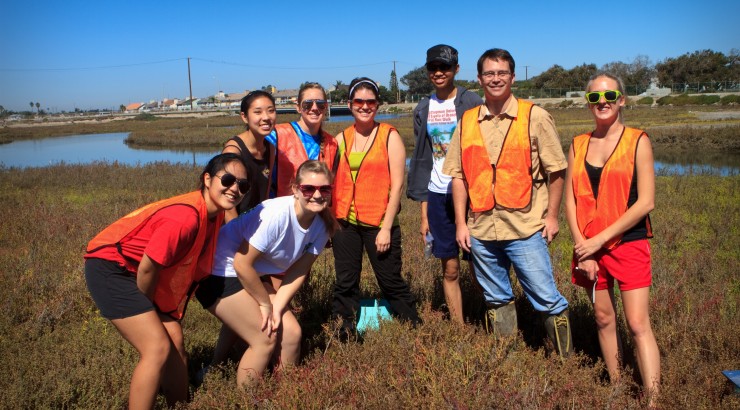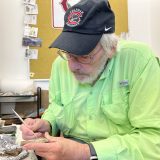Dr. Keller’s research blurb featured in The Pickleweed
July 8, 2013
Professor Keller was recently tasked to write about his experiences during previous research at the Huntington Beach marshes. Below is his detailed and colorful blurb of that research from 2011. The blurb was featured in this year’s Spring-Summer newsletter for the Huntington Beach Wetlands Conservancy. Enjoy!
Exploring “Blue Carbon” in the Marsh
By Prof. Jason K. Keller, Chapman University
(Originally published in The Pickleweed, Newsletter of the Huntington Beach Wetlands Conservancy, Inc.)
Mention “blue carbon” at a cocktail party and you will likely turn the heads of coastal managers, economists, and wetland ecologists. What is it about this colorful term that has captured the attention of such a diverse audience?
Blue carbon describes the carbon stored in coastal ecosystems, including salt marshes, mangroves and seagrass meadows. Carbon enters into these ecosystems when plants convert carbon dioxide from the atmosphere into organic matter (leaves, roots, and other plant biomass). When these plants die, a fraction of this organic matter (now dead plants) is left behind in the soil. Coastal systems, including the Huntington Beach Wetlands, are particularly adept at storing large amounts of organic matter in their soils because they are constantly accreting soil – they must build up new layers of organic-rich soil to keep their “heads above” sea level. A recent estimate suggests that salt marsh soils may store up to 40-times more carbon in a given area than soils in even the lushest tropical rainforest!
At this point, you have the attention of wetland ecologists, but what draws the economists and coastal managers into this conversation? The movement of atmospheric carbon dioxide into longer-lived carbon pools such as soil organic matter is termed carbon sequestration. As a number of groups explore carbon markets and carbon cap and trade systems, there is an economic value for carbon sequestration because it removes greenhouse gases from the atmosphere. In theory this means that one could sell the carbon stored in a wetland and, perhaps, help offset the cost of marsh restoration projects.
Obviously the utility of this mechanism will be linked to the value of carbon in the future and, to be fair, there are a number of important scientific and policy questions to be answered before this becomes practical. Despite those caveats, the idea of capitalizing on blue carbon to enhance coastal conservation is intriguing.
Undergraduate students at Chapman University have begun exploring blue carbon in the Huntington Beach Wetlands. As part of an Ecosystems Ecology course, we measured organic matter in soil collected from the upper 20 inches of both Talbert and Brookhurst Marshes. We initially hypothesized that soil organic matter should accumulate following successful restoration, and expected to see higher carbon content in Talbert Marsh than in the 20-year “younger” Brookhurst Marsh. We were surprised to find the exact opposite – in general, there is more carbon in Brookhurst Marsh soils than in Talbert Marsh soils. This suggests that in addition to time since restoration, initial site conditions will be important for understanding blue carbon dynamics in salt marsh soils. These results, as well as others from our work, have been published in the Bulletin of the Southern California Academy of Sciences.


